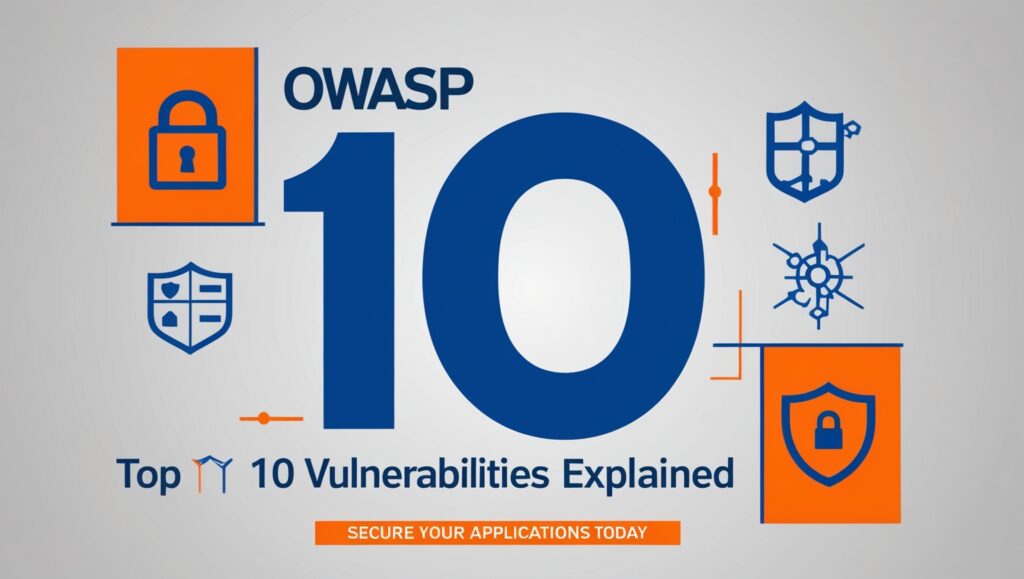When it comes to web application security, understanding the OWASP Top 10 Vulnerabilities Explained is critical for developers, security experts, and organizations. These vulnerabilities represent the most common and severe security risks identified by the Open Web Application Security Project (OWASP), a nonprofit organization dedicated to improving software security.
This guide dives deep into the OWASP Top 10 Vulnerabilities Explained, offering insights into their impact, mitigation techniques, and why they should be a priority for anyone developing or testing web applications.

1. Introduction to OWASP and Its Importance
The Open Web Application Security Project (OWASP) is a globally recognized organization that provides free resources and tools to help organizations develop secure software. Among its initiatives, the OWASP Top 10 stands out as a benchmark document highlighting the ten most critical security risks for web applications.
Why is this list important? It serves as a roadmap for developers and security professionals to identify and mitigate vulnerabilities that could lead to devastating data breaches, financial loss, or reputational damage. By addressing these risks, organizations can strengthen their overall security posture.
2. What is the OWASP Top 10 List?
The OWASP Top 10 is a regularly updated document that ranks the most prevalent and severe security vulnerabilities affecting web applications. It is based on extensive research, data analysis, and input from security experts worldwide. The list not only highlights vulnerabilities but also provides guidance on how to detect, exploit, and mitigate them.
3. Detailed Explanation of Each Vulnerability
Here are the OWASP Top 10 Vulnerabilities Explained in detail:
4.1 A01:2021 – Broken Access Control
- What It Is: Occurs when users can access resources or functions they are not authorized to use, such as escalating privileges or viewing sensitive data.
- Mitigation: Implement proper role-based access control (RBAC), enforce least privilege, and regularly test access permissions.
4.2 A02:2021 – Cryptographic Failures
- What It Is: Weaknesses in encrypting sensitive data, such as using weak algorithms or storing passwords in plaintext.
- Mitigation: Use strong encryption algorithms like AES-256, avoid hardcoded keys, and encrypt sensitive data both at rest and in transit.
4.3 A03:2021 – Injection
- What It Is: Includes SQL, NoSQL, and LDAP injections, where untrusted input manipulates queries to gain unauthorized access to databases.
- Mitigation: Use parameterized queries, prepared statements, and validate/sanitize user inputs.
4.4 A04:2021 – Insecure Design
- What It Is: Refers to a lack of secure architecture or practices during the software development lifecycle.
- Mitigation: Adopt secure design principles like threat modeling, secure coding standards, and architectural risk analysis.
4.5 A05:2021 – Security Misconfiguration
- What It Is: Commonly caused by default configurations, exposed debug information, or unnecessary features being enabled.
- Mitigation: Regularly update and patch software, disable unused features, and apply secure configuration baselines.
4.6 A06:2021 – Vulnerable and Outdated Components
- What It Is: Using outdated libraries or frameworks can expose applications to known vulnerabilities.
- Mitigation: Regularly update components, use tools like OWASP Dependency-Check, and remove unused dependencies.
4.7 A07:2021 – Identification and Authentication Failures
- What It Is: Weak authentication mechanisms, like weak passwords or insecure session management, can let attackers impersonate users.
- Mitigation: Use strong password policies, multi-factor authentication (MFA), and secure session handling.
4.8 A08:2021 – Software and Data Integrity Failures
- What It Is: Failure to ensure the integrity of software and data, such as unsigned code or improper updates.
- Mitigation: Use digital signatures, secure CI/CD pipelines, and verify software integrity before deployment.
4.9 A09:2021 – Security Logging and Monitoring Failures
- What It Is: Without proper logging, organizations may miss signs of security breaches or fail to respond in time.
- Mitigation: Implement centralized logging, monitor logs regularly, and set up alert mechanisms for unusual activity.
4.10 A10:2021 – Server-Side Request Forgery (SSRF)
- What It Is: Occurs when an attacker tricks a server into making unauthorized requests to internal or external systems.
- Mitigation: Sanitize all user inputs that generate requests, and restrict outgoing traffic to trusted endpoints.
4. Why the OWASP Top 10 Is Updated Regularly
The OWASP Top 10 is updated periodically to reflect the evolving threat landscape. New vulnerabilities emerge as technology advances, making it essential to reassess and address the latest risks. This ensures that developers and organizations stay ahead of attackers and remain compliant with modern security standards.
5. How to Test for These Vulnerabilities
Testing for the OWASP Top 10 Vulnerabilities Explained involves a mix of automated tools and manual techniques:
- Automated Tools: Tools like Burp Suite, OWASP ZAP, and Nikto can scan for vulnerabilities.
- Manual Testing: Conduct penetration testing to identify complex issues that automated tools may miss.
- Code Reviews: Regularly review application code for security flaws to prevent vulnerabilities before deployment.
6. Impact of Ignoring the OWASP Top 10
Neglecting the OWASP Top 10 vulnerabilities can result in:
- Data Breaches: Sensitive information being stolen or exposed.
- Financial Losses: Fines, lawsuits, and recovery costs.
- Reputation Damage: Loss of customer trust and brand credibility.
Real-world examples, such as the Equifax breach, show the devastating impact of ignoring security best practices.
7. Tips to Stay Ahead of Vulnerabilities
To stay protected from vulnerabilities, follow these tips:
- Adopt Secure Development Practices: Use a Secure Development Lifecycle (SDLC) to integrate security into each phase of development.
- Train Developers: Educate developers on secure coding practices and OWASP vulnerabilities.
- Update Regularly: Ensure all components are patched and up-to-date.
- Use Web Application Firewalls (WAF): Deploy WAFs and intrusion detection systems for added protection.
8. Conclusion
The OWASP Top 10 Vulnerabilities Explained is an essential resource for developers, testers, and organizations to build secure web applications. By understanding these vulnerabilities and implementing mitigation strategies, you can reduce the risk of security breaches and protect your applications.
Remember, security is a continuous process. Stay updated with the latest OWASP Top 10 and ensure your systems remain resilient to ever-evolving cyber threats.
Check More Blog:- https://thetechcrime.com/server-side-request-forgery-ssrf/
Check My YouTube Chenal:- https://www.youtube.com/@Thetechhacker231

Leave a Reply